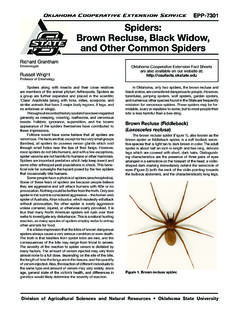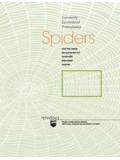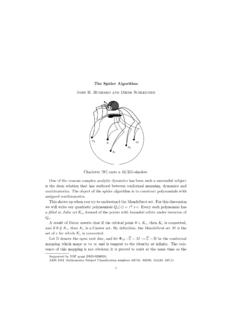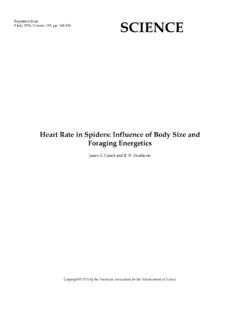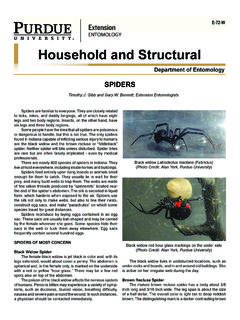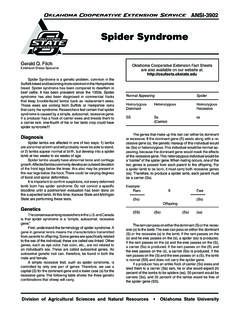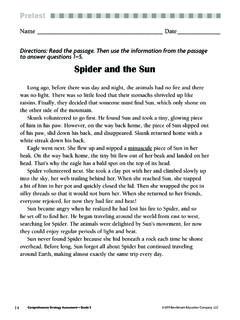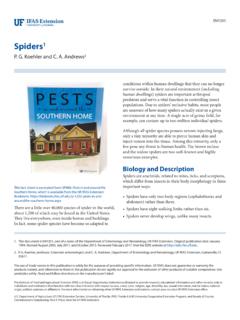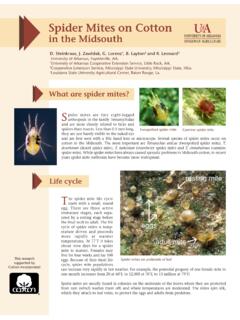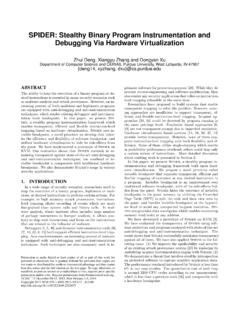Transcription of Spiders in West Virginia - Department of Agriculture
1 west Virginia Department of Agriculture Kent A. Leonhardt, Commissioner1900 Kanawha Blvd., EastCharleston, WV ** west Virginia Department of Agriculture1900 Kanawha Blvd., EastCharleston, WV 25305~ Contacts ~WVDA Executive Division: 304-558-3200 WVDA Plant Industries Division: 304-558-2212 WVDA Communications Division -Market Bulletin: 304-558-3708 Spiders in west Virginia Looked upon with fear and regarded with disgust by most people, the spider is truly a misunderstood creature. Superstition, folklore, ignorance and the ominous appearance of the Spiders themselves has contributed to these attitudes. The common belief is that all Spiders are poisonous to man. The facts are that, except for two small groups of Spiders , they are harmless to man and, in fact, are benefi cial since they feed mainly upon insects. All Spiders do possess venom glands which empty through small holes in the tip of the chelicerae or jaws . The venom is used to kill or subdue prey, but the great majority os Spiders cannot effectively pierce the skin of man or rarely have the opportunity.
2 On the rare occasions when they do bite man there is either no reaction or a very slight reaction in the form of transient pain. There are some indications that a few people are hypersensitive to the venom of even the harmless Spiders and, if bitten, would require attention, however, these individuals are rare. The unjustifi ed phobia or fear of Spiders may play as important a part in the reaction as the venom itself. Many people fear Spiders because they believe they are aggressive and will attack and bite without provocation. Not so! Only one spider in the world is considered aggres-sive. This is the funnel-web spider of Australia, Atrax robustus, which reputedly will fi ght anything that comes its way. Other Spiders are shy and retiring and will only become aggressive when cornered, injured or annoyed. Many Spiders will rush to investigate a disturbance of the web, for this is a natural response for those Spiders which depend on the web as a food catcher and does not represent an attack on man.
3 Spiders have few natural enemies and, in fact, they may be their own worst enemies. The young Spiders are often cannibalistic on their own brothers and sisters, older Spiders will feed on other Spiders and females do occasionally devour the males after mating. Several species of wasps feed on Spiders and when Spiders are around, man seldom passes up the chance to kill the ugly common belief is that all Spiders are poisonous to man. The fact is, except for two small groups of Spiders , they are harmless to man and, in fact, are benefi cial since they feed mainly upon insects. 1 2 Wolf SpidersThe Wolf Spiders (Lycosidae) are the largest and perhaps one of the most com-mon Spiders in west Virginia . Because of their large size, appearance and rapid reac-tions they are generally feared by man. The venom from two of the largest species has been tested on laboratory animals and found to be harmless. The chances of personal contact is slight since these Spiders do not normally inhabit buildings and beat a rapid retreat in man s Spiders carry their young around on their backs.
4 After the young Spiders emerge from the egg sac they climb up onto the mother s abdomen and are carried by her for a considerable time. If the mother is killed the young will scurry away from her. This reaction has led to the superstition that the dead spider immediately produces hundreds of little Spiders to take its tarantulas are not likely to be seen in west Virginia unless they arrive from the south on imported goods and commodities. Because of their large size (a female may have a leg spread of over fi ve inches) and fi erce hairy appearance they truly have an undeserved reputation for dangerous-ness. The venom of the tarantula is only slightly toxic to man, however, the bite from the strong jaws or fangs can infl ict a somewhat painful tarantulas of the tropics do produce a venom virulent enough to be harmful to man but it would be a rare thing indeed to encounter a tropical tarantula in west Virginia . The jaws of the tarantula work vertically rather than horizontally as do most spi-der s jaws.
5 For this reason, when annoyed by man or animals, they raise the front of the body in preparation for using their fangs in a raking manner and appear to be exceptionally fi erce. The bite of the tarantula would feel like a pin prick, with mild pain and soreness, however the possibilities of being bitten by a tarantula in west Virginia are ts of SpidersThere are hundreds of species of Spiders in west Virginia that are either benefi -cial or neutral in relation to man. The great majority are distinctly benefi cial to man by destroying injurious or unwanted insects in the garden or home. Mass extermination of Spiders should be avoided except when they become a nuisance. In many southern parts of the United States, Spiders are not only tolerated but encouraged to live in the house as assistants in the job of pest control. Some Spiders have been known to eat bees, but this undesirable behavior should be overlooked when you consider that they also eat hundreds of harmful insects such as mosquitoes and fl Common Spiders In addition to the Spiders previously discussed, the homeowner will often encounter the common house spider and the long-legged cellar spider or daddy longlegs.
6 The lat-ter is not a true spider , but it is a close relative. The house spider spins webs in darker corners and feeds on whatever insects are available. The daddy longlegs are often found in basement areas, under porches and in old sheds. They feed on plant juices and both dead and living Control Sanitation is the most practical method of control. Clean up all webs when they are fi rst noticed; and when needed, insecticide sprays may be used as directed on the package. Many products for the home are available in aerosol containers. For specifi c, current chemical insecticide recommendations, contact the west Vir-ginia Department of Agriculture s Agricultural Pest Survey Programs Unit, your county extension agent or the extension specialist in plant pathology and entomology at west Virginia Pesticides With Care And Follow Label DirectionsFor additional information about Spiders , the following book How To Know The Spiders by Kaston, is recommended.
7 7 is from these places that most bites have been recorded to have occurred. Outdoors it lives under rock ledges and other areas where it is not likely to be Brown Recluse is slightly smaller than the Black Widow and its color varies from orangish-yellow to dark brown. The legs are long and somewhat darker than the body. The most distinguishing characteristics are the peculiar arrangement of its six eyes and a violin shaped darker area on the cephalothorax (this section of the body is comprised of the head and the thorax and bears the legs and mouth parts.) This colored marking has led to the spider being called the violin or fi ddleback spider in some Brown Recluse s Bite Both males and females have venom and both are capable of infl icting poisonous bites. The symptoms are not at all similar to the symptoms of the black widow s bite. Typically the victim may not be aware of having been bitten for two or three hours, however a painful reaction may sometimes occur immediately.
8 The initial stinging sensa-tion is usually followed by intense pain. A small blister may arise at the site of the bite and a large area around the bite becomes swollen and congested. The patient may develop fever, become restless and have diffi culty in sleeping. The tissue affected locally by the venom is killed and gradually sloughs away, exposing the underlying tissue. The edges of the wound become thickened and raised while the central area is fi lled with dense scar tissue. Sinker scars ranging from the size of a dime to that of a half-dollar have been reported. The necrotic condition just described is typical of all bites of the Brown Recluse. In some cases a general systemic reaction has also occurred. The patient may break out in a rash resembling scarlet fever or the kidneys may be affected causing bloody urine to be passed. These reactions are rare and no doubt result from a maximum amount of venom being injected. The young, elderly and people in ill health are most likely to be seriously affected.
9 Hospitalization would usually be required in these to Aid treatment should be confi ned to the application of an antiseptic to the bite area to prevent infection and the use of ice packs to localize the venom. As soon as possible the patient should be placed under the care of a physician. At present there is no specifi c antivenin and therapy is usually supportive and possible, the spider infl icting the bite should be placed in alcohol in as good a condition as possible and sent to the west Virginia Department of Agriculture , Agricul-tural Pest Survey Programs Unit, 1900 Kanawha Boulevard, East, Charleston, west Virginia , 25305, for positive identifi cation. 6 The Orb Weavers The orb weavers of the family Araneidae are common out-of-doors where they construct webs between the foliage of plants or weeds as snares with which to capture their prey. Some construct a retreat some distance from the snare in which they await a disturbance of the web which would indicate a trapped insect.
10 Others remain motionless in the center of the web, hanging head down in most cases. Some of these Spiders construct a dense band of silk above or below (or both) the center of the web which is known as the stabilmentum and it may be straight or zigzag. One common spider of the genus Argiope is the common Black and Yellow Garden spider . This spider constructs a zigzag stabilmentus which many superstitious persons interpret as omens of misfortune or signs of approaching good times. These Spiders have received the common name of Writing Spi-ders for this reason. Like the other Spiders mentioned so far, these are harmless although their habit of spinning large webs between weeds and grass make them an annoyance to hikers or casual Crab Spiders The crab Spiders belong to the family Thomisidae and can be easily recognized by their crab-like habit of moving side ways and by the appearance of the legs, which resemble many of the crabs without large Spiders are wanderers and capture their prey by stealth rather than be weav-ing snares.

